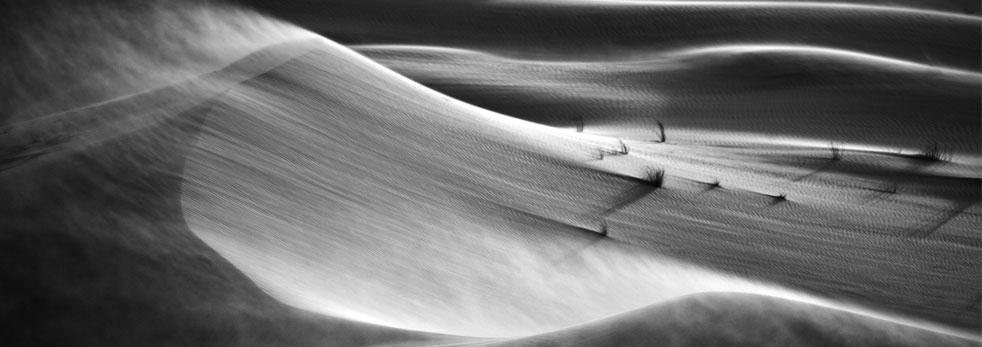
Mohammed Arfan Asif an Indian National based in the United Arab Emirates for more than two decades, has been involved with photographic art right from his school days. The late 1980s saw him exhibiting his works in National and International photographic expositions. He has received a number of international distinctions and awards for photographic merit and services rendered in photography. Arfan has lectured on photographic subjects, judged photo contests, written columns for photography and natural history magazines and traveled to exotic destinations in pursuit of photographic subjects. Presently, Arfan mentors a small group of photographic enthusiasts in Dubai and aspires to make images that are meaningful and interesting.

‘A soulful encounter with dunescapes’
The dunes as a subject fascinated me right from my early days in photography when I saw some images from colorful Rajasthan in India. Landscape photography as a genre requires a different approach, as well as, different equipment. Mainly having done portrait photography during most of my photographic journey, the lure of landscape photography provided more possibilities in a creative pursuit. The rules of the game, as they say, though there are no rules in art and it is no game, changed with the inanimate subject!
In any kind of nature photography, understanding the natural history associated with the subject is essential. The dunes have an interesting background and physical geology that help us appreciate them all the more. To keep matters simple, dunes are basically hills of sand created by wind-related processes over time. It is important to comprehend that all dunes are not the same and a number of factors a ect dunes.
Different types of dunes caused by various wind patterns provide a range of photographic approaches. The crescentic dune as seen from the top view is quite distinct from the other dune types that include linear, dome, star and parabolic. The crescentic or rather the “barchan” type of dune are primarily good subjects for photographers notwithstanding the fact that they are the most common dunes in the desert world. By noting wind direction one can make out the type of dune. Barchans are found in constant wind regimes that do not change in intensity or direction for years. A planned approach to photography can be exercised based on sunlight direction and season.
The dune with its various parts that include horns, ripples and, in particular, their slip faces are the focus of attention for photographic possibilities. The play of light and shadow, contrast, textures are important features to emphasize design and pictorial content. The geometric probabilities of the slip face have always caught my attention. There are simple dunes in places where I have visited often to notice the wind regime has not changed in direction or intensity for years. The complex dunes are the ones that spring a surprise and provide more variations in approach. The popular barchans are the classic shaped dunes having only one wind direction to the bene t of little or no vegetation. However, the photographic possibilities of complex dune systems, which are at the mercy of the winds, should not be ignored.
Another interesting phenomenon is seen when the sand supply increases around the barchans. The dunes begin to connect with other barchans forming ridges and these traverse dunes also provide great possibilities for imaging. The sand sheet of the dune can be covered by arid vegetation. These could form the “nebkha” or coppice dunes, where the simple dunes form around vegetation. As the sand gets deeper the plants grow taller, allowing more sand to gather around them. The dunes can have di erent vegetation with lollypop like trees, skinny trees, tall and short trees and a variety of shrubs. The dunes in di erent regions of the desert terrain can have a range of colors, like white, browns, yellows and reds for interesting color photography. For the discerning photographer, the same sand can look di erent with di erent seasons. Also, dunes can appear di erent with the time of day. The intensity of light striking them in relation to existing cloud cover can also a ect the hue of the sand.
Interestingly, dunes move. In Ningxia, China, a group of dunes moved more than 100 meters per year between 1954 and 1959. I am reminded of an experience not long ago, when a sudden sandstorm took me by surprise. Incidentally, I did not take cover but tried to capture the raging sand blowing with great intensity. This sand storm provided a rare opportunity to present the moving sand among the dunes and the unique character of my subject!
Photographic gear used for dune photography needs to be reviewed. As one who does less talk on gear, I could easily summarize that quality glass is preferred, however, it is more important to approach the subject with sensitivity. Various focal lengths from wide to telephotos would meet di erent compositional requirements. Protecting equipment and changing lenses among the dunes is a tough proposition. The chances of ne sand scratching lenses and getting onto the sensor can create serious problems. On most occasions, a tripod on dunes may not be feasible.
.jpg)
Personal care and avoidance of risk are issues to be kept in mind. The sand below has a variety of creatures hibernating or taking refuge from the intense heat during the day. These creatures could pose a threat if disturbed unintentionally. I have experienced a variety of creatures that includes scorpions and snakes. Interestingly, avian and reptile species inhabiting the dunes present footprints, which themselves are subjects of curiosity and photography.
Amidst the dunes, I am one with nature. It has often been an opportunity for introspection on nature and its incredible diversity and glory. They say when you are in nature you don’t have to look in mirrors! Importantly, I am at peace with myself when photographing the dunes. They have provided me endless possibilities to make images and satisfy my urge for creative pursuit.
When among the dunes having walked well into its interiors, particularly the harsh and vast ones, encountering a lone shrub surviving the harsh surroundings or, for that matter, dead trees, camel skulls and bones, one appreciates more about life and natural cycles. Exploring sand dune environments can be an emotional experience for the photographer.
My feelings for nature and the dunes have evolved over time and made me realize that not only do I behold its beauty, but also, that I am part of it!
Website: www.arfanasifphotography.com
Image Gallery
Copyright © 2024. All rights reserved. PAWS TRAILS EXPLORERS